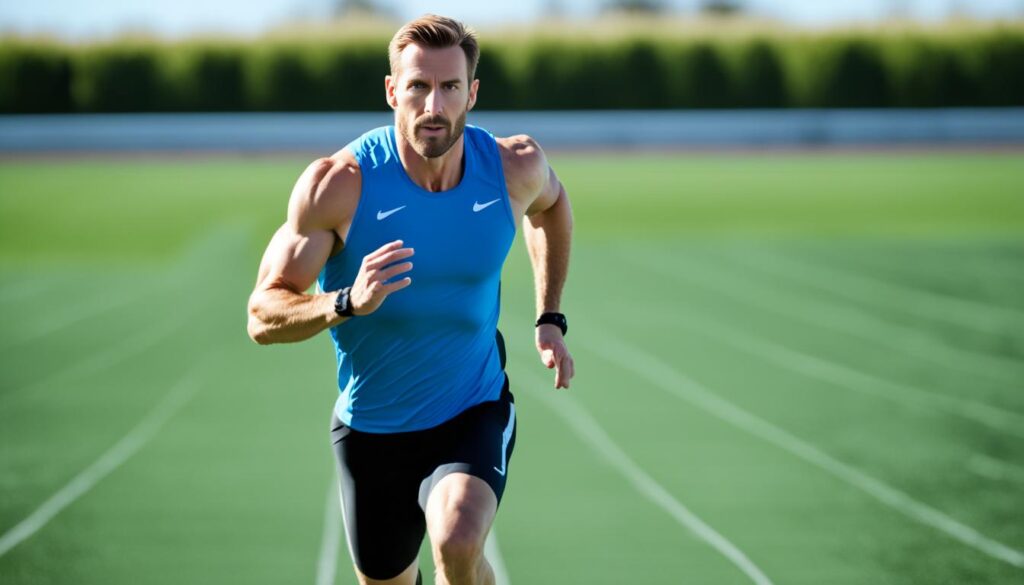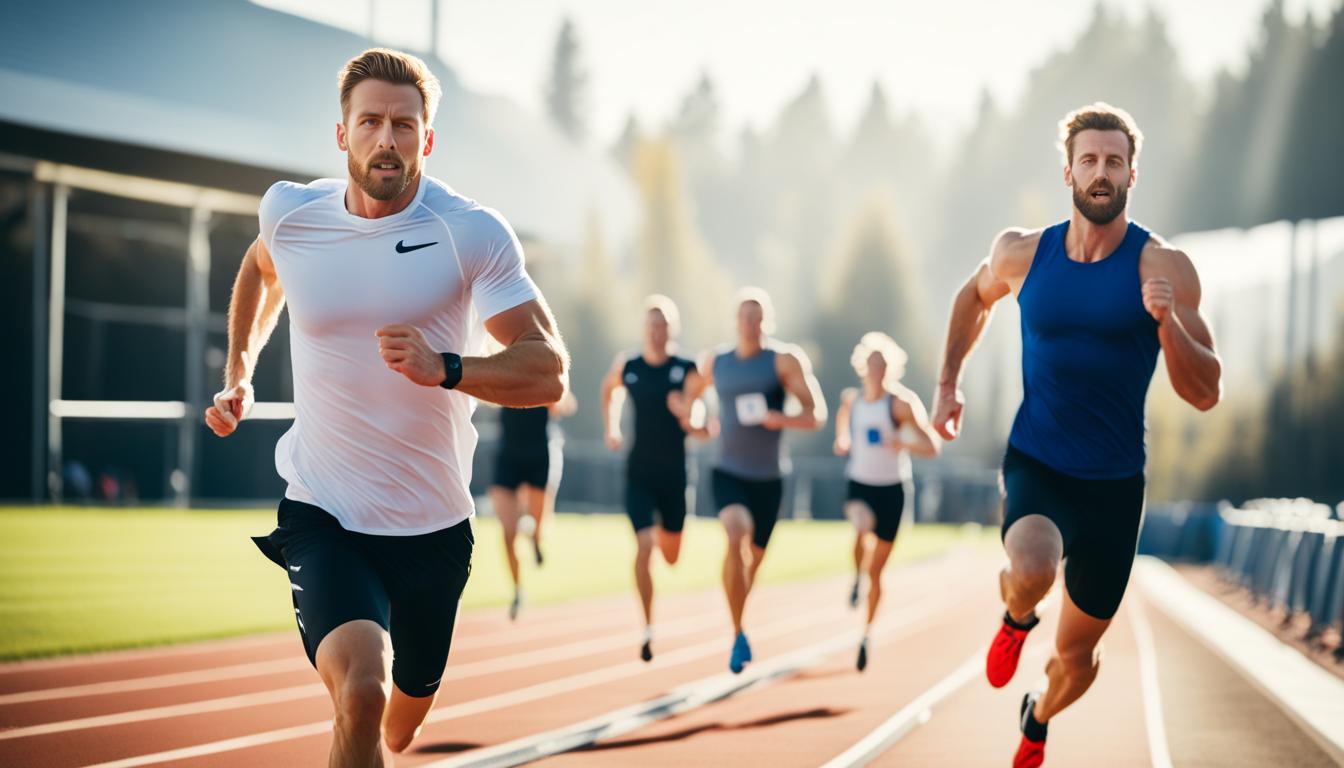Did you know Usain Bolt hit an incredible 27.8 mph in his record 100m sprint? Most of us won’t match Bolt’s speed, but we can still get a lot faster. For all from weekend warriors to future stars, learning to improve running speed blends science and art. This article is your guide to effective how to run faster exercises, sprinting workouts, and running technique tips to cut seconds off your best time.
Speeding up, whether on a track or in a marathon, means targeted training. Boost your stride and lower injury chances by mixing exercises. They should work key muscles and polish your technique. We’ll share methods that, if done right and often, can boost your speed and break your records.
Key Takeaways
- Mastering sprinting takes strength, technique, and regular training.
- Exercises for key muscle groups greatly improve running speed.
- Sprinting workouts and drills boost power and running skill.
- Running technique tips focus on leg speed, posture, and efficient movement.
- A mix of plyometric, strength, and technical exercises forms a full speed program.
- Sticking to a set training plan makes big speed gains more likely.
Understanding the Mechanics of Speed
To understand speed, one must explore the physiology and biomechanics behind it. It’s not just about hard work, but also smart training. With the right running drills for speed and speed training for runners, athletes can improve dramatically.
Physiology Behind Running Faster
Speed improvement starts with knowing how acceleration and velocity work. Running drills help increase stride length and frequency, which are key. These aren’t just simple exercises; they aim to make one run faster and more efficiently. Adding strength training increases muscular capacity, helping in quick starts and maintaining speed.
The Role of Muscle Fibers in Speed
Muscle fibers are crucial for runner’s speed. Fast-twitch fibers, important for sprints, respond quickly and generate a lot of force. Strength training helps develop these fibers, boosting speed potential. By combining training for both fast and slow-twitch fibers, runners can be fast without losing endurance.
Importance of Running Economy
Running economy is key in speed training. It measures how well a runner uses oxygen while maintaining pace. Improving running economy means you can run faster with less effort. Focusing on better biomechanics and energy use enhances a runner’s economy. This leads to better endurance and faster speeds on the track.
By focusing on these aspects of running science, athletes can aim high in their speed goals. They can turn the dream of quick running into reality at races.
Incorporating Staggered Stance Exercises
To boost your sprint speed, adding certain exercises to your plan is crucial. Focusing on staggering stance exercises helps build muscle and coordination. They simulate the movements of a fast sprint. Such exercises are great for fixing muscle imbalances and strengthening legs, which are key for sprinting workouts.
We’ll look at specific exercises that can really help your sprinting ability. These include moves traditional squats and deadlifts don’t cover. Exercises like lunges, rear foot elevated split squats, and single-leg Romanian deadlifts work on your lower back, hips, and knees together. This is important for improving your sprinting extension phase. If you do these regularly, they can help you become faster and more powerful on the track.
Lunges are a basic yet important exercise for staggering stance routines. They require stability and endurance, making you use your core and legs a lot. Here are some more exercises designed for sprinters:
| Exercise | Primary Muscles Worked | Unilateral Balance Contribution | Extension Phase Simulation |
|---|---|---|---|
| Static Lunge | Glutes, Hamstrings, Quads | High | Medium |
| Rear Foot Elevated Split Squat | Glutes, Hamstrings | Very High | High |
| Single-leg Romanian Deadlift | Hamstrings, Lower back | High | High |
| Walking Lunge | Quads, Glutes, Core | Medium | High |
These exercises are key for better motor control, which is necessary for a strong and quick stride. Strengthening these areas helps you perform better in sprinting workouts. It gives you the power to outrun others in a race.
To sum up, adding a mix of staggering stance exercises to your routine is essential. It’s not just extra training; it’s fundamental for sprinting success. Commit to these unilateral exercises to improve your leg strength and balance. Then, watch how they help you sprint faster and with more accuracy.
Maximizing Hamstring Workouts for Speed Gains
Hamstring workouts for speed are critical to cut sprint times. Your hamstrings help push you forward, so they must be strong. Nordic hamstring curls will greatly aid in this, boosting both speed and preventing injuries. Finding the right mix of eccentric and concentric strength is key for explosive speed.
Nordic Hamstring Curls and Their Impact
Nordic hamstring curls are top for speed-focused leg training. They target hamstrings in a stretch, mimicking sprinting actions. This makes the muscles stronger for running.
Balancing Eccentric and Concentric Hamstring Strength
To amp up your sprinting, you need more than big muscles. Your muscles must handle running’s demands without getting hurt. A balanced development in strength can help achieve this, making you run better and safer.
| Exercise | Primary Benefit | Eccentric Focus? | Concentric Focus? |
|---|---|---|---|
| Nordic Hamstring Curls | Enhances hamstring resilience and sprinting speed | Yes | No |
| Single-leg Hip Thrusts | Boosts hip drive during sprints | No | Yes |
| Deadlifts | Builds overall posterior chain strength crucial for sprinting | No | Yes |
| Squats | Increases general leg power and stability | On descent | On ascent |
Add these exercises to your training for faster running times. With a well-rounded routine, you’ll see great results on the stopwatch.
Plyometric Exercises for Enhancing Sprinting Performance
Discover how plyometrics can boost your sprinting speed, a key part of elite athletes’ training. These exercises strengthen explosive power and are essential for speed training for runners. They help athletes launch faster by building quick, powerful muscle actions.
Building Explosive Power with Plyometrics
Plyometrics turn the muscle’s quick stretch-and-contract actions into sprinting strength. This explosive power helps athletes get better, reach explosive starts, and speed up faster than others.

Types of Plyometrics for Speed Improvement
To get faster, you can try different plyometric exercises for speed. Here’s a table showing some key drills for boosting speed:
| Exercise | Focus Area | Benefits |
|---|---|---|
| Box Jumps | Vertical power | Improves height and force of jumps, knee drive during sprints |
| Depth Jumps | Reactive strength | Boosts rapid muscle response and lowers contact time with ground |
| Single-leg Broad Jumps | Unilateral power | Enhances balance and unilateral explosiveness for each leg |
| Hill Bounding | Overall explosive strength | Builds leg strength and power while improving gravity resistance |
| Resistance Jumping | Force output under load | Increases muscle power with added resistance, simulating acceleration phases |
Adding these plyometric exercises for speed to your workouts twice a week can greatly improve your running. Keep at it, and you’ll gain the explosive strength and speed you’re aiming for on the track.
Key Foot and Calf Exercises for Runners
For better running, you need to do foot and calf exercises. These help build the muscle support needed to increase your running pace and speed. With the right training, your feet and calves become strong tools. They help you run faster and with more precision.
Effective running drills for speed work on making the lower legs stronger. They also make the ankle joint better at sending force during runs.
Adding different exercises to your routine helps your muscles get stronger in more ways. This leads to a power-packed and efficient running style. Here’s a short list of exercises to boost your lower body’s power.
- Single-Leg Calf Raises – Focus on strength and stability.
- Seated Calf Raises – Work on the deeper calf muscles.
- Eccentric Heel Drops – Make your Achilles tendon stronger and more flexible.
- Toe Walks – Build strength and stability in your foot and toe muscles.
- Foot Domes (Foot Shortening) – Improve your arch support and control.
Each of these exercises is a piece of the puzzle to make your feet and calves stronger. This is crucial for getting faster and avoiding injuries. Below is a table that explains these running drills for speed in simple steps:
| Exercise | Primary Focus | Repetitions | Frequency |
|---|---|---|---|
| Single-Leg Calf Raises | Gastrocnemius and Soleus muscles | 10-15 per leg | 3 sets, 2-3 times per week |
| Seated Calf Raises | Soleus muscle | 15-20 | 3 sets, 2-3 times per week |
| Eccentric Heel Drops | Achilles tendon and calf complex | 10-12 per leg | 3 sets, 2 times per week |
| Toe Walks | Foot and toe flexors | 30 seconds walk | 3 sets, 2 times per week |
| Foot Domes | Arch support and proprioception | Hold for 15 seconds | 8-10 repetitions daily |
The goal of these foot and calf exercises is to improve more than just your running look. They also support the parts of your body that help you run faster. Stick with it and gradually add more work. This is how these exercises make your running pace better and build your athletic skills.
To sum up, add these exercises to your weekly plan to see your pace get better. It’s the strength, quickness, and toughness in your feet and calves that help you reach the end. Train them well, and they will help you achieve great distances.
Refining Running Technique for Maximum Efficiency
Improving your running technique is more than just running. It’s a mix of movements that boost your speed and efficiency. By focusing on little details of their form, runners see big improvements in their performance. Important elements include the right running posture and how you swing your arms. Both are key to your running rhythm and push-off.
Proper Posture and Its Effects on Speed
Good posture is crucial for efficient running. It involves leaning slightly forward from the ankles, keeping your spine straight, and chest up. This position helps you breathe better and use your abs. It leads to a stronger running stride.
To improve, try weighted planks and pull-ups. These exercises build core strength and ensure your upper body helps, not hinders, your leg power.
Arm Swing Mechanics in Running
Many people overlook the importance of how they swing their arms when running. Your arms should move opposite to your legs. This helps you keep going and stay balanced. Aim for a tight arm swing with elbows at 90 degrees. It aids in speed and keeps you running straight.
Adding overhead presses and good mornings to your workout helps too. They strengthen your arm swing and improve coordination with your legs for a faster run.
To run better, work on your posture and arm swings. These changes make running more fun and effective. Remember, it’s not just about working hard. It’s also about how smoothly you can run.
Agility Exercises to Improve Acceleration
Runners focus on agility exercises to get quicker. These drills help increase sprint speed and boost acceleration. They work on body strength and the brain’s ability to adapt. This makes it easier for runners to change direction fast and powerfully.
Acceleration workouts help athletes speed up quickly. They go from standing still or jogging to their fastest speed fast. The drills copy the movements and reactions needed in races. Doing these exercises often improves a runner’s quickness.
- Lateral Shuffles: Enhances side-to-side agility, critical for swift changes in direction while maintaining speed.
- Cone Drills: Boosts footwork precision and agility, important for runners who need to navigate through crowded races or avoid obstacles.
- Tuck Jumps: Develops lower leg explosive power, directly translating to a faster launch off the blocks.
- Box Drills: Improves coordination and muscle activation, stimulating both the nervous system and muscular responses necessary for quick acceleration.
Agility exercises also sharpen an athlete’s mind. Quick direction changes and smart moves in these drills give runners an edge. They become faster in thinking and moving, helping them in races.
| Exercise | Benefits | Recommended Frequency |
|---|---|---|
| Lateral Shuffles | Increases lateral movement speed and stability | 2-3 times per week |
| Cone Drills | Improves agility and footwork | 2-3 times per week |
| Tuck Jumps | Builds explosive leg power | 1-2 times per week |
| Box Drills | Enhances coordination and nervous system activation | 2-3 times per week |
By doing these specific agility exercises often, runners build a strong base for faster sprints. With regular practice and correct technique, they’ll see big improvements. This leads to better performance and makes them stand out among competitors.
The Role of Recovery in Running Performance
Understanding how vital passive recovery is can change the game for athletes. It’s essential to incorporate rest periods into your training. This approach helps boost performance and endurance over time. Here, we highlight key running recovery strategies crucial for runners aiming to improve.

Running recovery strategies mean more than just taking breaks. They include many restful practices. These help to refresh the body and prepare it for more physical activity. We’ll look into how passive recovery impacts runners and boosts their performance.
| Recovery Strategy | Description | Benefits for Runners |
|---|---|---|
| Adequate Sleep | A restful, uninterrupted sleep of 7-9 hours each night. | Promotes muscle repair, mood regulation, and cognitive functions. |
| Proper Hydration | Consistent intake of fluids to replenish what is lost through sweat. | Facilitates nutrient delivery to muscles and aids in waste removal. |
| Nutritional Intake | Balanced diet rich in proteins, carbohydrates, fats, vitamins, and minerals. | Provides the necessary building blocks for muscle recovery and energy restoration. |
| Relaxation Techniques | Practices such as meditation, light yoga, or deep-breathing exercises. | Decreases stress levels and promotes a restorative state within the body. |
Focusing on passive recovery helps runners avoid overtraining dangers. It also lays the groundwork for steady improvement. Remember, achieving top performance is a long journey, not a quick race. Learning to recover is as important as the training. Let these strategies help you reach your highest running potential.
How to Run Faster Exercises with Proven Success
Everyone wants to run faster, whether you’re an athlete or not. People try hard training, speed exercises, and a strong commitment to get better. This hard work can take you from beginner to pro, bringing incredible changes in your skills.
Success Stories: Athletes Who Transformed Their Speed
Being great at sports takes lots of practice and the right exercises. There are many stories of athletes who became much faster thanks to specific drills. These stories prove that focusing on speed really works, helping athletes break their own records.
From Amateur to Pro: Exercises That Make a Difference
Moving up from an amateur to a professional sprinter is amazing. It shows how good speed workouts can make you much faster. Here are some exercises that have helped athletes become much quicker and more skilled.
| Exercise Type | Benefits | Frequency |
|---|---|---|
| Sprint Drills | Increases stride efficiency and neuromuscular coordination | 2-3 times per week |
| Hill Repeats | Builds leg strength, power, and improves running form | 1-2 times per week |
| Speed Endurance Training | Enhances the ability to sustain high speed over longer distances | 2 times per week |
| Lower Body Strength Work | Increase musculature ability to generate force | 2-3 times per week |
| Upper Body Strength Work | Improves posture and arm drive, contributing to overall speed | 2 times per week |
Interval Training: The Path to Boosting Speed
Interval training is a great way to make your running faster. It mixes short, high-effort runs with rest periods. This method not only improves running speed but also builds endurance. Let’s explore how to design an interval training plan for more speed and why it’s vital to track your progress.
Designing an Interval Training Session for Speed
Interval workouts cater to both new and experienced runners. When planning, it’s key to think about the runner’s level, speed aims, and stamina. You can pick from different types of intervals, like fast sprints or uphill runs, to push your limits.
- Figure out your current speed and set achievable goals.
- Choose intervals that match your objectives, like 30-second sprints or 200-meter repeats.
- Include rest time, which is needed to keep the session effective.
- Balance the workout’s volume and intensity with your fitness to avoid overtraining.

Monitoring Progress with Interval Workouts
Tracking your progress is vital in any training plan. Keeping a log of your interval workouts helps analyze your performance. This way, you gather useful data for planning future sessions. As your speed and endurance grow, you can fine-tune the length and intensity of your intervals.
- Record every workout, noting how far you ran, your speed, and feelings.
- Use a stopwatch or an app to measure your performance accurately.
- Pay attention to how your body reacts; a plateau might mean it’s time for a change.
With careful planning and tracking, interval training can greatly enhance your running speed. Every effort you make during your running sessions brings you closer to your goals.
Implementing Speed Training in Your Routine
Looking to beat your own records? Adding speed training for runners into your weekly schedule is a must. This training boosts your speed and improves your overall running pace. Knowing how to mix these exercises into your routine is the first step towards faster running.
To start, pick two or three days a week for speed work. It’s important to rest in between these tough workouts. This rest time helps your body recover and build muscle. Begin with tempo runs to get used to a quicker pace. Then, add in high-intensity interval training (HIIT) to boost your aerobic and anaerobic levels.
Speed training is not a sprint; it’s a marathon of consistently pushing your limits.
Adding resistance training is crucial too. Doing hill repeats strengthens your sprinting muscles and builds endurance. And exercises like parachute sprints add more resistance. This forces your muscles to grow stronger, making you faster.
- Tempo Runs: Builds endurance to maintain increased speeds
- High-Intensity Interval Workouts: Improves aerobic and anaerobic stamina
- Hill Repeats: Enhances strength and endurance
- Parachute Sprints: Increases resistance for muscle conditioning
Remember, staying consistent is important. Track your speed session times and see how your body reacts to different exercises. Every improvement is a step towards being a quicker, more efficient runner.
Conclusion
Finding your top running speed isn’t just about fast legs. It’s about the combined power, agility, and precision in every move. This series shows that increasing speed involves a mix of exercises strengthening all key muscles. Through the exercises we’ve talked about, like plyometrics and detailed footwork, athletes can unlock new levels of speed, achieving personal bests with every stride.
Running faster exercises conclusions help us see a crucial fact: speed can be reached by anyone ready to train hard. By combining specific stances, strengthening exercises, and technique improvements, athletes build a strong base. This helps them handle competition while being super efficient. True speed requires a whole-body approach in training.
As we go on this speed journey, we learn the finish line marks progress, not the end. With proper exercises and a focus on form, becoming faster isn’t just a dream. It’s something that’s about to happen. Driven by the desire to be better and smart training, runners can set new records for themselves, breaking speed limits along the way.
FAQ
What are the best exercises to run faster?
To run faster, include sprinting workouts and staggered stance exercises. Focus also on strengthening your hamstrings, plyometrics, and refining your foot and calf workouts. Don’t forget about improving your technique.
How does running economy affect speed?
Running economy shows how well a runner uses oxygen at a certain speed. A better running economy uses less energy. This allows for a quicker pace and better endurance.
Why are staggered stance exercises beneficial for running faster?
Staggered stance exercises help with the running extension. They target your hip, knee, and lower back at once. This builds strength and control, important for a powerful sprint.
How do Nordic hamstring curls impact running speed?
Nordic hamstring curls focus on full-range hamstring strengthening. They’re key for fast sprints and preventing injuries. They improve muscle strength both when stretching and contracting.
What types of plyometrics are effective for speed training?
For speed, choose plyometrics that boost explosive power. Try broad jumps, depth jumps, box jumps, hill bounding, and resistance jumping. These are great for getting faster.
What foot and calf exercises can help improve my running pace?
Single-leg calf raises and foot raises are good for your pace. They boost your feet and calves’ force. This leads to a more efficient and faster run.
Can refining running technique really make me faster?
Yes, better running technique, like proper posture and arm movement, boosts your speed. It makes you run more efficiently.
What agility exercises can improve my acceleration?
For quicker acceleration, try lateral shuffles and acceleration drills. They enhance your strength and control. This helps in rapid direction changes and boosts sprint speed.
How important is recovery in improving running performance?
Recovery helps with muscle repair and lowers injury risk. It’s key for better running performance. Good sleep, water, and food are essential for recovery.
What success stories demonstrate the effectiveness of speed workouts?
Many athletes have boosted their sprint times with sprint drills, hill repeats, and strength training. Their success proves the value of these exercises.
How do I design an interval training session for speed?
Create an interval session with high-intensity bursts and rest periods. Adjust it to your fitness level and goals for the best speed improvement.
Can speed training really be implemented by anyone in their exercise routine?
Yes, speed training suits all levels. With regular practice and workouts, anyone can enhance their sprinting speed.

